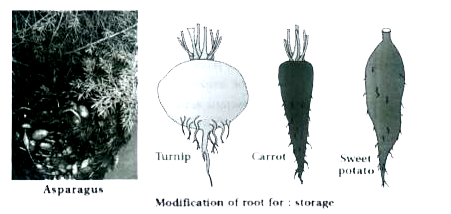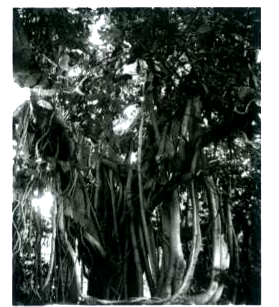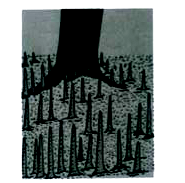Describe modifications of root specific functions.
Text Solution
Some plants perform some specific functions in addition to their main functions.
For these functions their shape and structure are changed . Such functions are called specific functions and for that the changes that take place in their structure are called modifications.
They are modified for support , storage of food and respiration.
Modifications of plants for food storage :
( a ) Food storage in Tap root : Food is stored in tap root of carrot and it becomes cone shaped . Food is stored in Raddish and becomes spindle shaped . Food is stored in beet root and Turnip and becomes top shaped.
( b ) Food storage in Adventitious root : Food is stored in adventitious root of sweet potato and get swollen . So it is called simple Tuberous root.
In Asparagus and Dahlia food storing root clusters are formed . They are called Fasciculated tuberous root.

Modifications of root for support : Prop roots and stilt roots are modifications for support.
( a ) Stilt Roots : The stems of maize and sugarcane have supporting roots coming out of the lower nodes of the stem . These are called stilt roots . e.g. Maize , Sugarcane , Pandanus etc.
( b ) Prop Root : The hanging structures that support a tree are called prop roots . e.g. Prop roots of banyan tree.

(c) Pneumatophores : The plant group developing in swampy and humid areas of salt water at seashore is called Mangrove.
Many roots of these plants develop towards opposite direction of gravity and longitudinally from soil directly.
Such root are porous and unbranched . It helps to get oxygen for respiration . They are called Pneumatophores or respiratory root.

|
Topper's Solved these Questions
- MORPHOLOGY OF FLOWERING PLANTSBOOK - KUMAR PRAKASHANCHAPTER - MORPHOLOGY OF FLOWERING PLANTSEXERCISE - Section-B (Diiference /Scientific Reasons)
4 Videos
- MORPHOLOGY OF FLOWERING PLANTSBOOK - KUMAR PRAKASHANCHAPTER - MORPHOLOGY OF FLOWERING PLANTSEXERCISE - Section-B (Give scientific reasons)
3 Videos
- MINERAL NUTRITIONBOOK - KUMAR PRAKASHANCHAPTER - MINERAL NUTRITIONEXERCISE - QUESTIONS FOR MODULE (IMPORTANT MCQ FOR NEET)
4 Videos
- NEURAL CONTROL AND COORDINATIONBOOK - KUMAR PRAKASHANCHAPTER - NEURAL CONTROL AND COORDINATIONEXERCISE - OBJECTIVE SECTION (FILL IN THE BLANKS)
12 Videos
Similar Questions
Knowledge Check
Root modification is
APermanent internet changes in rootsBTemporary internal changes in rootsCPermanent structural changes in rootsDTemporary structural changes in roots.Roots are modified to perform specific functions other than their normal functions.The given figure shows modification of the roots of mangrove plant.Select the incorrect option regarding it.
 AThe stilt roots of red mangrove help in breathingBThe root system is highly entangled, huge and extensive under the water.CA large number of animals such as small fishes, crustaceans, seahorses, etc. find shelter in this root systemDBesides providing mechanical support, these roots also perform photosynthetic functions in the plant.
AThe stilt roots of red mangrove help in breathingBThe root system is highly entangled, huge and extensive under the water.CA large number of animals such as small fishes, crustaceans, seahorses, etc. find shelter in this root systemDBesides providing mechanical support, these roots also perform photosynthetic functions in the plant.Roots are modified to perform specific functions other than their normal functions.The given figure shows modification of the roots of mangrove plant.Select the incorrect option regarding it.
 AThe stilt roots of red mangrove help in breathingBThe root system is highly entangled, huge and extensive under the water.CA large number of animals such as small fishes, crustaceans, seahorses, etc. find shelter in this root systemDBesides providing mechanical support, these roots also perform photosynthetic functions in the plant.
AThe stilt roots of red mangrove help in breathingBThe root system is highly entangled, huge and extensive under the water.CA large number of animals such as small fishes, crustaceans, seahorses, etc. find shelter in this root systemDBesides providing mechanical support, these roots also perform photosynthetic functions in the plant.
adventitious roots modifications, root modifications for special functions, stem- general characters, bud- general characters
View SolutionDescribe various modifications of the leaf.
View SolutionDescribe the modifications of leaf in any one isectivorous plant.
View SolutionDescribe different modifications of tap root system.
View SolutionWhat is meant by modification of root? What type of modification of root is found in the
(a) Banyan tree
(b) Turnip
(c) Mangrove trees
View Solution
